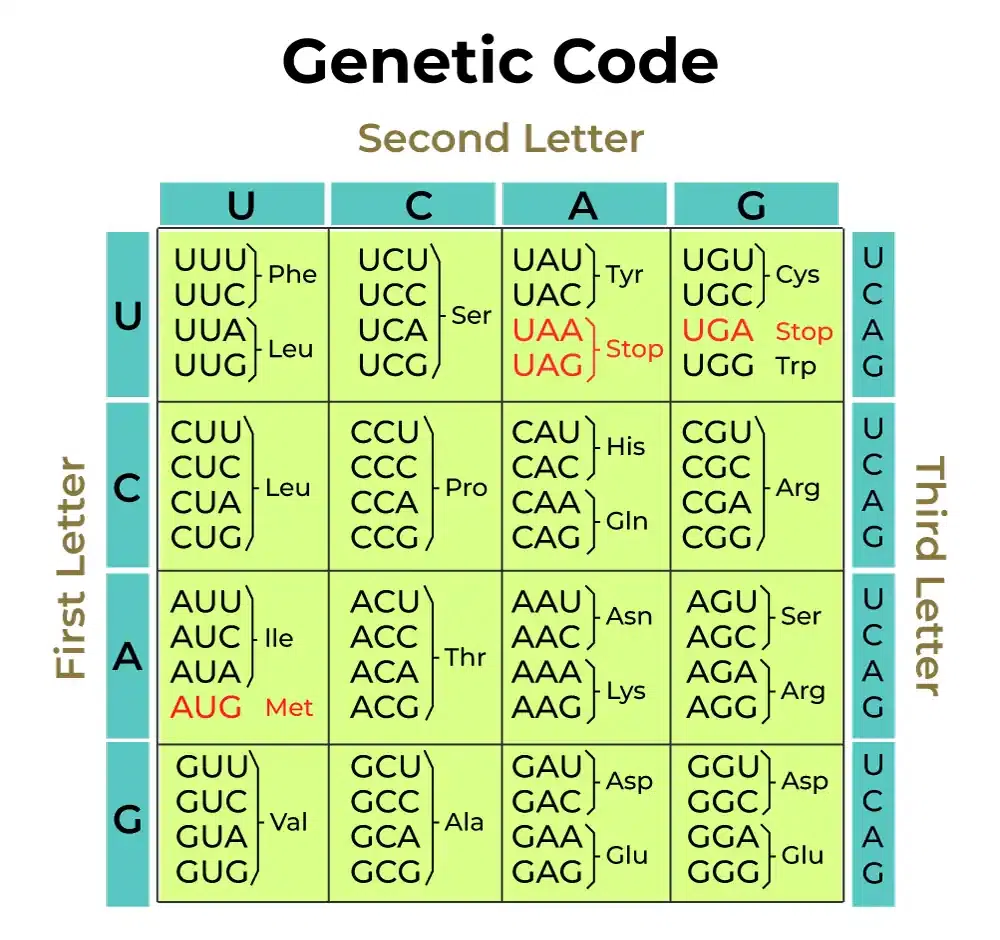Genetic Code – Molecular Basis of Inheritance
Last Updated :
01 Jun, 2023
CBSE Class12- Molecular Basis Of Inheritance- Genetic Code: The sequence of nucleotides in deoxyribonucleic acid and ribonucleic acid which determines the amino acids sequence of proteins is known as Genetic code. DNA consists of information for protein sequences. RNA consists of four nucleotides: adenine (A), guanine (G), cytosine (C), and uracil (U). The genetic code is made up of three nitrogen bases which are known as the triplet code.
What is Genetic Code
Genetic code refers to the nucleotide sequence of the base on DNA or RNA which translated into sequences of amino acids sequence of proteins.
A nucleic acid was copied to form another nucleic acid during the process of replication and transcription. The process of translation needs to transfer genetic information from the polymer of nucleotide to the polymer of amino acids. Some evidences were there to support the notion that changes in nucleic acids were responsible for the change in amino acids of the proteins which led to the preposition of genetic code that direct the sequence of amino acids during the synthesis of proteins.
George Gamow, a physicist said that there are only 4 bases, and if they code for 20 amino acids then the code should consist of the combination of bases. Further, he suggested that to code for all 20 amino acids the code should be made up of 3 nucleotides. This was the bold preposition because of the permutation combination 43(4*4*4).
Salient features of the genetic code are
- There are some amino acids that are coded by more than one codon therefore the code is degenerate.
- There are 61 codons that code for amino acids and 3 codons which doesn’t code for any amino acids therefore the codon are triplet.
- AUG has dual functions which code for Methionine (met).
- The stop terminator codons are UAA, UGA, and UAG.
- The genetic code is nearly universal.
- The codon is read in mRNA in a contiguous fashion, therefore, no punctuations.

What is Genetic Table?
The set of relationships between amino acids and codons is known as genetic code. When a genetic code is summarized in a table it is known as a Genetic code Table. Amino acids represent in the table by more than one codon. Example – In total, there are 6 ways to write leucine in mRNA language.
Properties of Genetic Code
- Nonoverlapping Code: When a code read in a group that initially becomes part of the triplet which becomes a part of the triplet and can never again become a part of the next triplet is known as a nonoverlapping code.
- Degenerate Code: Except tryptophan and methionine every amino acid is coded by other codons therefore some codons are synonyms and this is known as the degeneracy of genetic code.
- Triplet Code: Strong proof is available that sequences of three nucleotides code for an amino acid in the protein is known as triplet. There are 64 codons for 20 amino acids where every codon for amino acid means that there exists more code for a same amino acid.
- Universal Nature or Non-ambiguous: Same genetic codes are seen in all organisms which means they are universal in nature whereas genetic code is non-ambiguous for a particular codon that will code for a particular amino acid.
- Comma less Code: No room for punctuation is there in between them which shows every codon is adjacent to the previous one without any nucleotides between them.
- Start and Stop Codons: The start codon is the AUG codon whereas the stop codons are UAG, UGA, and UAA.
- Polarity: The triplet can read from 5′ – 3′ directions, the beginning base is 5′ followed by the middle and last the last base which is 3′. Therefore these codons have fixed polarity.
Exceptions of Genetic Code
Due to similar codons being seen in all organisms, the genetic code is universal along with the same START and STOP signals in the genes of microorganisms and plants. Therefore there are few exceptions which include one or two STOP codons of an amino acid.
Though GUG is meant for valine both the codons GUG and AUG code for methionine as starting codons which breaks the property of non-ambiguousness. Therefore, few codes are different from universal code or non-ambiguous code.
FAQs on Genetic Code
Q1: What do you mean by Genetic code?
Answer:
Genetic code refers to the sequence of nucleotides in deoxyribonucleic acid and ribonucleic acid which determines the amino acids sequence of proteins.
Q2: State why the genetic code degenerates.
Answer:
The genetic code degenerate because some amino acids are coded by more than one codon.
Q3: Discuss why the codon is a triplet.
Answer:
There are 61 codons that code for amino acids and 3 codons which doesn’t code for any amino acids therefore the codon are triplet.
Q4: Write some features of the genetic code.
Answer:
Some of the features of the genetic code are:
- AUG has dual functions which code for Methionine (met).
- The stop terminator codons are UAA, UGA, and UAG.
- The genetic code is nearly universal.
- The codon is read in mRNA in a contiguous fashion therefore no punctuations.
Share your thoughts in the comments
Please Login to comment...